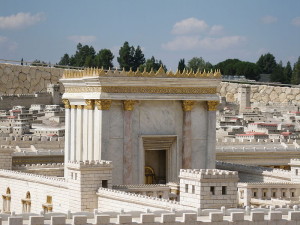Herodian Rule
 Excerpted from Lawrence H. Schiffman, From Text to Tradition, Ktav Publishing House, Hoboken, NJ, 1991.
Excerpted from Lawrence H. Schiffman, From Text to Tradition, Ktav Publishing House, Hoboken, NJ, 1991.
What follows is but a brief summary of the life and dynasty of the most famous and infamous of Judean kings, known to history as Herod the Great. From the beginning of his reign, popular discontent, which he had already faced as governor of the Galilee, reached high proportions, led by certain Pharisees and some of the nobility. Only with harsh and brutal measures did Herod succeed in bringing it under control. In 35 B.C.E., to shore up his hold on the throne, he installed the Hasmonean Aristobulus III as high priest and married Mariamme, his sister. However, realizing that Aristobulus, as a descendant of the Maccabees, was very popular, Herod soon had him drowned. This was only the first of a chain of killings he perpetrated, often against members of his own family regarding whom he harbored the darkest and most irrational of fears.
Having set to rest the internal challenges to his control, Herod soon faced other problems from abroad. Called before Antony in 34 B.C.E. to defend himself for the death of Aristobulus, Herod was acquitted. Yet Cleopatra VII, the queen of Egypt, persuaded Antony soon afterwards to give her possession of certain territories in the region of Jericho that were among the best agricultural lands in Herod’s kingdom. Rather than resist and alienate this powerful woman, Herod cleverly arranged to lease back his own land. In this way, paying what amounted to a small tribute, he retained his territory intact. Although Herod’s war with the Nabatean Arabs ended in victory in 31 B.C.E., his army suffered great casualties. That same year an earthquake killed some thirty thousand people and Herod had to undertake massive relief works in its aftermath. When Antony was defeated at the battle of Actium, Herod quickly changed sides in the Roman civil war and allied himself with Octavian, now known as Augustus Caesar. In gratitude, Augustus confirmed Herod in office in 30 and returned to him the territories taken by Cleopatra.
Domestic, internecine jealousies led Herod to put his wife Mariamme to death in 29 B.C.E. The resulting psychological depression and recriminations led in turn to the execution of other family members and courtiers. Among them were other Maccabean descendants, killed for fear that they might reassert the claims of the Hasmonean house.
The consolidation of Herod’s power made possible a variety of massive building projects that befitted his status as a Roman client king. Theaters and amphitheaters were constructed. He built a palace in the upper city of Jerusalem, as well as the Antonia fortress north of the Temple. In non-Jewish areas, both within his kingdom and outside, he built temples to pagan gods and in honor of Caesar and funded athletic games. Although quite Hellenized, and born of a non-Jewish mother, hence not Jewish according to the predominant view, he often sought to avoid offending his Jewish subjects. At other times, however, he completely violated Jewish laws and sensibilities. From 22 to 9 B.C.E. he built the port of Caesarea on the Mediterranean coast, intended as a shipping point to foster his role in the international grain trade. Many fortresses were rebuilt, including Masada, where he had hidden his family when he fled to the Roman Senate in 40 B.C.E.
Herod’s largest and most beautiful project was the rebuilding of the Jerusalem Temple. He began in 20/19 B.C.E., yet work on the details was still proceeding long after his death when the Temple was destroyed by the Romans in 70 C.E. Although Herod adhered to Pharisaic demands regarding many aspects of the Temple’s construction, he ignored them in other respects. In consequence, the Pharisees continued to be hostile to him, and it is even doubtful that the Sanhedrin functioned in his time. Herod appointed and removed high priests at will. The Sadducean elements, therefore, were also opposed to him, as were the heavily taxed common people. He was able to maintain control only because of his extremely close relations with Augustus and the Roman authorities and because of the repressive tactics he used to subjugate the populace.
The last years of his reign were dominated by family intrigues. (He had had a total of ten wives.) Herod’s son from his first marriage, Antipater, schemed successfully against the sons of Mariamme, Alexander and Aristobulus. Eventually, Herod accused them of treason before Augustus, then had them tried and executed, probably in 7 B.C.E. When Antipater sought to gain control of the kingdom, he was accused of plotting to kill Herod and was imprisoned. As Herod’s domestic situation deteriorated, so did his health. In 4 B.C.E. he executed Antipater and gave instructions that a large group of leaders of the country were to be put to death after he died, a plan that never took effect. Five days after his son’s execution, he died. The entire country breathed a sigh of relief as the reign of this despot and murderer came to an end.



